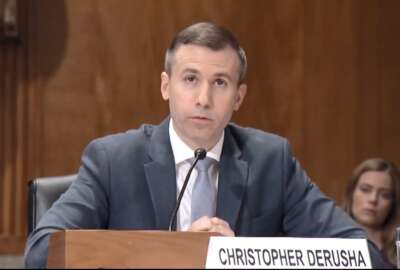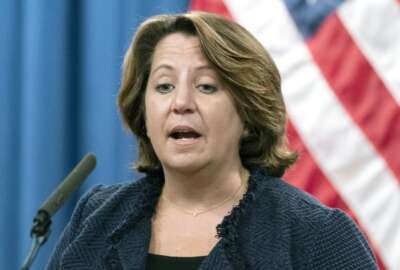Hubbard Radio Washington DC, LLC. All rights reserved. This website is not intended for users located within the European Economic Area.
On Air: Federal News Network
Trending:
AGA survey says data sharing remains a huge challenge to fighting cyber fraud
It's money they want - cyber criminals and fraudsters of all types. To get a better handle on the latest risks and mitigation strategies, the Association of Gov...
Best listening experience is on Chrome, Firefox or Safari. Subscribe to Federal Drive’s daily audio interviews on Apple Podcasts or PodcastOne.
It’s money they want – cyber criminals and fraudsters of all types. To get a better handle on the latest risks and mitigation strategies, the Association of Government Accountants and consultants Guidehouse surveyed AGA members. With highlights of what they discovered, the Guidehouse partner for public sector financial services, Caitlin McGurn, spoke to Federal Drive with Tom Temin.
Interview transcript:
Tom Temin: Ms. McGurn, good to have you on.
Caitlin McGurn: Thanks for having me. Good to be here.
Tom Temin: Now you did this study with the Association of Government Accountants. Is fraud and that type of abuse actually the purview of the accounting function in government? Or should it be the program and the inspector general and somebody else?
Caitlin McGurn: So Tom, the way I look at it, it really should be a collaboration between the entities that you just described. So the accounting functions certainly has a role when it comes to fraud, but all of those parties need to work together to make sure that it’s properly mitigated.
Tom Temin: And what did you find that respondents felt were the biggest contributors to fraud? What were their concerns here?
Caitlin McGurn: So I would say one, the pandemic is certainly contributing to the increase in fraud risk that we’re seeing. The other thing that’s really trending towards the increase is the increased sophistication of fraudsters, their use of technology, their use of cyber crimes to ultimately implement the fraud schemes that they’ve developed. And when we step back and take a look at things right now, with a pandemic, and if you think about the fraud triangle, you have the three points, opportunity, pressure, rationalization. And really what the pandemic did was put an opportunity to increase each one of those three points.
Tom Temin: And I wanted to ask you about one detail in the study, again, looking just at the executive kind of overview here. Data sharing that has been a important imperative for government, we dat it back to 9/11, but even before that, on the security front. On the fraud, and making sure that there is program integrity front, what is the role of data, sharing? What data and who do you share it with?
Caitlin McGurn: It’s interesting that you bring up 9/11. When we approached the survey, what we did is we actually issued a true survey, we had over 300 respondents, once we got those responses back, we actually conducted a number of deep dive qualitative interviews. Data sharing came up in almost every one of those interviews, and many individuals compared it back to the pre-9/11 days. And what we discussed was that within the government, it could be federal, state, or local data resides in a number of different sources, different formats. So there are a number of barriers right now to data sharing. It could be the format, it could be the quality and cleanliness of the data. But it also could just be a lack of connection points, and or legislation that prevents the sharing of that data. If we can overcome those obstacles, that will greatly increase our ability to fight fraud at all levels of government.
Tom Temin: And let’s back up for just a moment. Is it the opinion of the people that you surveyed, these government accountant types of folks, the financial function, that fraud is on the rise?
Caitlin McGurn: It is. So what we found is that 53% of our respondents believe that fraud is on the rise. What’s interesting about this is we conducted the survey in March of 2021. Since then, there have been an increased number of pandemic relief related programs. So I imagine that we re issued that question today, that number would be even higher.
Tom Temin: Yes, there’s a strong sense that the money was flowing and the programs developed much faster than the oversight and control mechanisms could actually be developed and put in place. Is that a fair way to say that they felt that way also?
Caitlin McGurn: I’d say that’s fair. And I think in some situations, it was, as you stated, it was moving so quickly, that they were not able to put those control mechanisms in place in time. In other situations, there was an intentional decision to scale some of those back to increase the speed at which the funds were getting out the door. In either situation, what that impacts is the fraud prevention piece of the puzzle. What we can do now is we can focus on the fraud detection piece. And one of the best ways for us to do this is to utilize technology so that we can get greater coverage and find those instances where funds went out the door in a way that they shouldn’t have, and hopefully be able to claw those back.
Tom Temin: We’re speaking with Caitlin McGurn, she’s a partner for public sector financial services at Guidehouse. So the idea of detection then takes tools for detection, and that brings us back to data sharing. Isn’t detection highly dependent on data analysis nowadays? It’s not something you can look at on spreadsheets.
Caitlin McGurn: Absolutely. What I would say is that data sharing increases our ability to more efficiently and effectively execute the fraud detection. And even at times the fraud prevention aspect of fraud, fraud management. We can get around it with the situation that we have, it’s just going to take a greater level of effort. But that actually comes back to one of the constraints that we found in the survey. And that’s that’s resource constraints. Resources in terms of both people and budgetary funds. So addressing the data sharing issue is a great way to be able to lower the level of effort needed to effectively manage progress.
Tom Temin: Does the government have any sort of metrics? Or are there any industry metrics on if a given amount of dollars is devoted to a program in terms of the benefits of billion dollars to help restaurants get out of trouble? Is there any kind of ratio for administrative cost that should accompany that billion dollars to ensure that the money is overseen properly and to prevent fraud?
Caitlin McGurn: That’s a great question, Tom. I don’t believe there’s anything at the centralized government level, I could be wrong on that. I know individual agencies are trying to look at those metrics, and manage and assess how their programs are doing in that regard.
Tom Temin: Now, you did have some good case histories throughout this report that showed that you can have some wins. Any successful strategies that you identified that could be shared with across government?
Caitlin McGurn: Yeah, absolutely. One of the themes that really came out for us was training and communication. And I’m going to cover this in two regards. So one training and communication in terms of making the most of the human capital resources that you have, getting them in the right training so that they can stay up to speed related to current fraud trends, current fraud schemes, making sure that they’re armed appropriately to be able to do their jobs as effectively as possible. And then I would also look at training as it pertains to technology. Technology is not a silver bullet. But what we’ve found is that it can help programs be more efficient and effective. At Guidehouse, we work with both public sector and private sector clients. And we’ve seen the adoption of technology at a much greater pace on the commercial side of things. And so we know that it does work, and ultimately reducing that level of effort. But one of the things we’ve taken from the commercial side is the importance of training. You can’t just implement a technology, set it and forget it, you need to make sure that you invest in it and train your human capital individuals so that they know how to best use that technology.
Tom Temin: Now the AGA has developed, I imagine in conjunction with Guidehouse, a fraud prevention toolkit. What’s in that toolkit?
Caitlin McGurn: Guidehouse can’t take credit for the toolkit, that is something that AGA has available. And I’m really excited that our survey is now part of that toolkit. The toolkit has best practices, guides, all of which are free and available to individuals that they can use to help with their programs. One of the other things that we came out with as a best practice here is that anyone in the organization that has fraud responsibilities can make an impact on their fraud program, and they can do it with simple, small, incremental steps, and leveraging AGA’s fraud prevention toolkit is a great way to get that started.
Tom Temin: And if you would maybe just run quickly through the six steps to fortifying your fraud management program.
Caitlin McGurn: The first one is really focused on your fraud risk assessment. What we found is that fraud risk assessments are key to making sure that your program is appropriately aimed. At a lot of times when you do experience resource constraints, you have time constraints, what you do, you skip that you go with what you know, but then what you’re doing is your program is aimed incorrectly. So doing those fraud risk assessments more frequently, and making sure that they’re done accurately is going to be very important. One of the other things that we found is agency culture is significant in terms of the impact that it has on the fraud risk management program. When it comes to agency culture, tone at the top is going to make a big difference. So making sure that the fraud risk program is being promoted by senior leaders.
Tom Temin: And best practice number three?
Caitlin McGurn: Training is going to be really important because fraud is ever changing. We’re seeing it evolve at a faster pace than we’ve ever seen before. So that training and that communication is really going to help programs make the most additionally incremental changes, can quickly help with agencies’ fraud prevention and detection efforts. Anyone should feel empowered to be able to take things here and make an improvement. We also talked about technology. Technology is one of the things that really surprised me in this survey, is nearly 1/3 of respondents don’t leverage technology in any capacity. There are a variety of technologies that can be used. Yeah, I was pretty startled by that. There are a variety of technologies that can be used. And they range across the spectrum from very low cost and effort and implementation. So we’re talking RPA to higher cost implementation. So there are small incremental steps as it pertains to technology as well, that can have significant benefits. And then lastly, no one needs to reinvent the wheel. As you mentioned, there are resources out there that individuals can use to see what’s going on in the space, see what the best practices are, and figure out how to apply those to their unique situation.
Tom Temin: All right, people so get on the stick. Caitlin McGurn is the partner for public sector financial services at Guidehouse. Thanks so much for joining me.
Caitlin McGurn: Thanks for having me. This was great.
Copyright © 2024 Federal News Network. All rights reserved. This website is not intended for users located within the European Economic Area.
Tom Temin
Tom Temin is host of the Federal Drive and has been providing insight on federal technology and management issues for more than 30 years.
Follow @tteminWFED
Related Stories
DoJ’s new Civil Cyber-Fraud Initiative to hold contractors accountable for cybersecurity
Related Stories
-
Fast and Furious: The Biden administration’s cybersecurity series Reporter's Notebook





